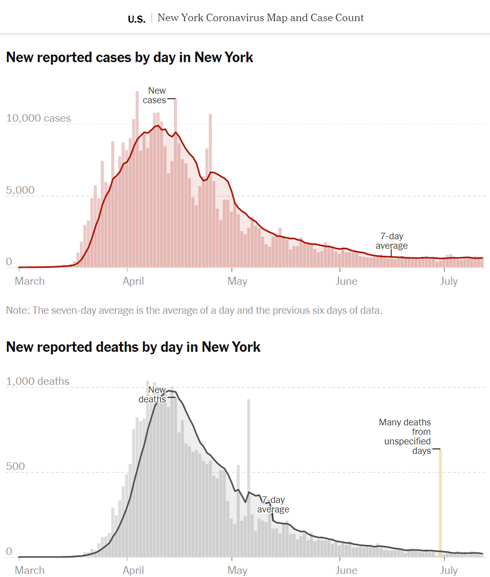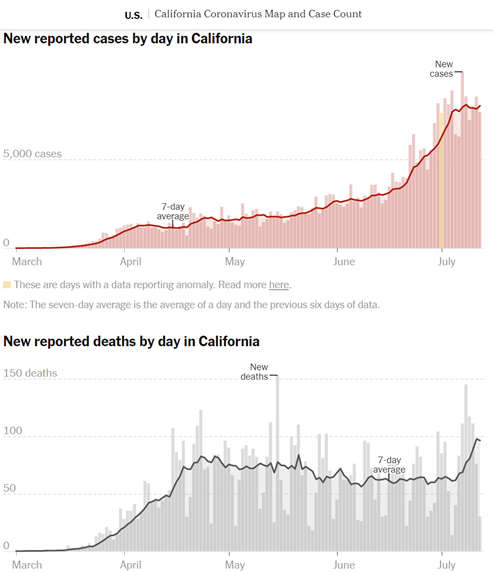What business sectors can be open without leading to runaway #COVID19 epidemics?
(CA closed back down a huge sector of businesses today)
A tough question with a huge lack of data, some unexpected wrinkles, and a path forward.
Thread https://twitter.com/GavinNewsom/status/1282752861835649024">https://twitter.com/GavinNews...
(CA closed back down a huge sector of businesses today)
A tough question with a huge lack of data, some unexpected wrinkles, and a path forward.
Thread https://twitter.com/GavinNewsom/status/1282752861835649024">https://twitter.com/GavinNews...
Background: Rapidly rising cases in March led to lockdowns in *most* states and countries around the world. Lockdowns were effective in bending the curve - shifting trajectories from exponential growth to long plateaus (CA:Apr-May) or, in some places, big decline (NY).
However, After 1-3 months of lockdowns economies were crushed, unemployment was huge, & partial lifting of lockdowns was needed to prevent societal meltdowns. But virus was still around and in many places lockdown only stopped rise (CA) but didn& #39;t lead to big decrease.
During that time we should have ramped up public health - testing, contact tracing, safe isolation space - and done a huge outreach & messaging campaign about what was going to be necessary to re-open the economy without returning to where we were in March.
In most states only minor achievements were made towards these goals, and most lacking was clear messaging about how to return life post-lockdown to avoid future lockdowns.
For example, we re-opened restaurants without requirements of no more than 1 household per table.
For example, we re-opened restaurants without requirements of no more than 1 household per table.
I& #39;ve written about this in detail before. Sadly we& #39;ve made no progress since. https://twitter.com/DiseaseEcology/status/1272271134696673281">https://twitter.com/DiseaseEc...
A prudent approach would have been to re-open segments of the economy bit by bit & see when transmission shifted from declining to increasing (after accounting for increased testing) & stop re-opening there & try to increase public health response - test-trace-isolate to help.
CA was initially pursuing this strategy and it seems that NY, NJ & MA are currently on this track. But over a short period of time CA tossed off the reins and opened almost everything with no messaging campaign, insufficient public health capacity, and much ongoing transmission.
So, CA has now locked back down on huge swaths of the economy that employ many people (restaurants: possibly ~2M; industry website so take w/ grain of salt https://www.restaurant.org/downloads/pdfs/state-statistics/california.pdf).">https://www.restaurant.org/downloads...
I think there is universal agreement (and common sense) that bars are too risky.
I think there is universal agreement (and common sense) that bars are too risky.
What& #39;s less clear to me is whether other businesses (e.g. restaurants) are always high risk or can be made low risk. I haven& #39;t seen studies showing transmission b/w people at different tables following reasonable guidelines - spacing, masks except when eating, good ventilation.
Almost all reports of cases from restaurants are from restaurant/bars and it& #39;s been pretty clear that even when owners tried to follow guidelines, (drunk) customers weren& #39;t being good citizens (further supporting the suggestion that alcohol makes social distancing unlikely).
Everyone knows of poor ventilation restaurant example from China (although most people don& #39;t seem to have read actual paper very carefully; same for choir paper: https://twitter.com/DiseaseEcology/status/1279664793087963136).
Everyone">https://twitter.com/DiseaseEc... agrees good ventilation will be key. Question is, is ventilation enough? Data?
Everyone">https://twitter.com/DiseaseEc... agrees good ventilation will be key. Question is, is ventilation enough? Data?
What is needed is compilation of case investigations by states&counties & assessment of how much of transmission is occurring at home vs in each business activity, whether it can be reduced, & whether it is important to economy (i.e. can workers be supported if it is closed?).
Again, to be clear: bars almost certainly can not be made safe; need to close AND be supported (owners AND employees).
What about other businesses?
What about other businesses?
Gyms are also being closed in CA. Can they be made low risk or are they like bars? We all know of S Korea dance class example. https://wwwnc.cdc.gov/eid/article/26/8/20-0633_article">https://wwwnc.cdc.gov/eid/artic...
But what about less aerobic activities, when spacing and ventilation is being used? One CA county is requiring all cardio be done outside but other activities (weights) indoors. Is that high risk w/ spacing & ventilation? Data???? https://www.mercurynews.com/2020/07/11/heres-what-can-reopen-in-santa-clara-county-starting-monday/">https://www.mercurynews.com/2020/07/1...
What about barbershops? Most people are aware of initial scare of infected hair cutter but follow up indicated no transmission. So can it be made low w/ masks, face shields & ventilation?
Data??? https://www.businessinsider.com/two-missouri-hairstylists-with-coronavirus-saw-140-clients-none-infected-2020-6">https://www.businessinsider.com/two-misso...
Data??? https://www.businessinsider.com/two-missouri-hairstylists-with-coronavirus-saw-140-clients-none-infected-2020-6">https://www.businessinsider.com/two-misso...
Given the devastating impact of lockdowns, they should be guided by data-driven decision-making, and I have not seen data guiding these decisions. I know the data exists. Health departments - please make your data available, but do so in an informative format.
One CA county showed slides w/ list of 17 outbreaks by categories w/ restaurant/bar, grocery, gym, healthcare setting showing up. But what were circumstances in these clusters?
https://www.sandiegocounty.gov/content/dam/sdc/hhsa/programs/phs/Epidemiology/covid19/MediaBriefingSlides/mediaBriefingSlides.pdf">https://www.sandiegocounty.gov/content/d...
https://www.sandiegocounty.gov/content/dam/sdc/hhsa/programs/phs/Epidemiology/covid19/MediaBriefingSlides/mediaBriefingSlides.pdf">https://www.sandiegocounty.gov/content/d...
In my county there was a "grocery store cluster" of cases but it turned out these co-workers socialized together; not a single shopper at store was infected, so it wasn& #39;t a "grocery store" outbreak - it was a social gathering transmission chain. https://goodtimes.sc/santa-cruz-news/coronavirus/aptos-new-leaf-reopens-after-cluster-of-covid-19-cases/">https://goodtimes.sc/santa-cru...
The difference is extremely important.
Should we fear going to the grocery store even if masks, distance implemented?
At 1st glance example above says yes, but w/ further investigation answer is no. No transmission despite multiple employees being infected.
Should we fear going to the grocery store even if masks, distance implemented?
At 1st glance example above says yes, but w/ further investigation answer is no. No transmission despite multiple employees being infected.
This issue applies everywhere and public has not received good guidance on what is risky and what isn& #39;t. People still think a "crowded" beach is high risk. Focus is still on hand-washing despite tons of data showing contact/fomite transmission rarely identified as important.
If we are going to get through epidemic without collapse of economy we need data-informed decision making and careful assessment of what is and isn& #39;t high risk. Needed both by decision makers & public.
But, I& #39;d argue most important issue is communication.
Even if restaurants could be made safe, does fact of them being open make people engage in unsafe close contact w/ other households outside restaurant? If so, how do we change this? That is real challenge going forward.
Even if restaurants could be made safe, does fact of them being open make people engage in unsafe close contact w/ other households outside restaurant? If so, how do we change this? That is real challenge going forward.
If we can& #39;t get people to stop having close sustained unmasked contacts with members of other households without business closures then we are doomed to economic disaster. But it doesn& #39;t have to be this way. https://twitter.com/DiseaseEcology/status/1272271134696673281">https://twitter.com/DiseaseEc...

 Read on Twitter
Read on Twitter



